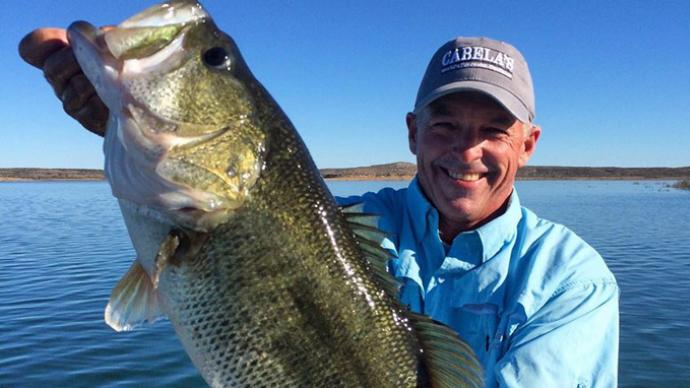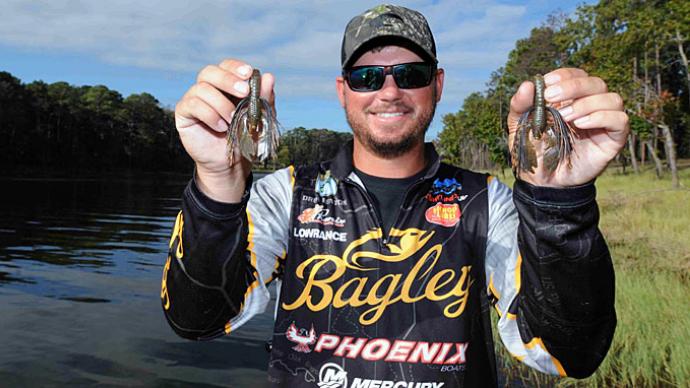
For those of you that regularly read my articles, you already know that I am most certainly a shallow-water fisherman and would much prefer to fish a row of docks or series of laydowns than a deep fish structure in 20 feet of water. Along those lines, I also opt to use a technique that seems to appear more while flats fishing the Caribbean for bonefish than it does bass fishing in a lake or river. What I'm talking about is sight fishing. Given the right conditions, it can prove not only a very effective tactic for putting bass in the boat. It quite possibly can be one of the most fun and rewarding also.
This is a primer for those who have never tried such an approach before but want to know more about it. Of course, many anglers could write entire books, let alone articles on sight fishing. However, a few fundamental principles can be considered ground rules and can be expanded upon to make it work for each angler.
Optics
To sight fish, one must first see the fish! Contrary to popular belief, this is the most challenging part of the entire equation, at least in my humble opinion. You are essentially looking for a dark-colored fish against a somewhat dark background. The human eye is very keen on the motion. However, it will not work as well when looking for a stationary object—for instance, a bass sitting on a piece of cover. So the first rule of thumb is to put every optical advantage you can in your favor.
As many of you may have guessed, the first of such advantages are polarized sunglasses. Polarized sunglasses help cut the glare off the water and increase the area and depth that we can view with our human eyes. (For more info on polarized glasses, you can refer to "Why Polarized," an article that I did specifically on these shades). Another essential thing these glasses do is increase the definition between shapes. Polarization alone doesn't do this. One needs something more - lens tints in the yellow range are one way to define better. This will give you aid in picking out shapes such as fish and bottom structures.
Water Clarity
When sight fishing, you will find that another critical factor is water clarity. While gin clear water makes for challenging and exciting sight fishing, it's also essential to remember clear water works two ways.
Sure it's easier to find and see bass in such water, but it's also easier for bass to see you as well as your boat and spook. Also, clear water will give bass a far better look at your offering and give them more time to determine if they want to strike or not.
Lightly stained water, namely that you can see the bottom and make out individual bottom features, but isn't clear to the point it's like fishing in a swimming pool, is a good thing. This will allow you to approach and make casts without spooking the fish you are trying to catch.
I also like to look for areas near the shore with many overhanging trees cast shadows. Often, predators such as bass will use the shadow lines and differences in light to ambush prey. It goes along the lines of one-way glass. Bass can see out into the sandy areas. However, prey cannot see the dark areas where the bass and other predatory fish hide.
By running bait parallel to the shadow line, you stand a good chance of having a bass attack the bait because it's using an ambush tactic. The same applies in saltwater when anglers target predatory fish on the flats.
Lighting
Light is another critical factor to consider when sight fishing. Sun, in my opinion, is a good thing, but don't rule out overcast days as potential sight fishing days.
While bright sunny days will offer you the best view into the water and the best chance of spotting fish, it also offers some drawbacks. It will make your presence far more known to the bass. This, because getting back to the one-way mirror example, bass will be looking up at you and can easily see your silhouette against a bright sky.
However, one distinct advantage to sight fishing on sunny days is that there will be well-defined shadow lines, which may get you a few ambush strikes. I prefer early morning or late afternoon as the sun will be lower in the sky, creating long shadows and better visual clarity in the water when searching for bass.
Overcast days can offer just as much in the way of sight fishing because of the lack of glare on the water. This will give you the added advantage of a sharper underwater picture and cut down on your silhouette, which will lower the number of fish you spook.
Bottom Structure
Now when most bass fishermen think of sight fishing, a nice smooth gravel flat comes to mind, possibly one with a few beds on it. However, some of the most rewarding and exciting sight fishing to be had involves heavy cover!
I can honestly say that some of the best sight fishing I have ever done has involved steering small finesse baits in and around laydowns, standing timber, rip rap piles, and boulders. For those of you that live in the northeast, nearly every body of water in the region can offer this type of fishing to some extent.
My personal favorite of these is the shallow stump field. In areas like this, the water isn't gin clear, there is vegetation mixed in among the stumps, and the stumps themselves are almost always used as cover for bass. This gives the bass cover and the angler a target and a reference point to cast at. Fish will generally be more active in these areas and more aggressive towards your offerings.
Don't overlook stump fields, large areas of laydowns, or any other shallow water structure as a potential sight fishing spot. Once again, shallow water littered with boulders makes a great smallmouth sight fishing setting that's an idea for light finesse baits that we will get into later.
Baits
As far as baits go for sight fishing, I could probably fill an entire book on possible selections and various ways of presenting them. However, in the interest time, I will outline a few of my favorites. Of course, the critical thing to remember is that the best way to find what works for you is to try it.
My go-to bait is the venerable tube bait in many of these circumstances. I will generally opt for a relatively dark-colored 3- to 4-inch lightly-weighted tube bait. I feel that the dark color forces bass to get up close and personal to see exactly what the bait is, rather than getting a good look at a brightly colored bait from a distance.
Watermelon, motor oil, and camo baits work particularly well in these situations. A 4-inch tube with a 1/16th ounce internal sinker in a Bluegill pattern produced well last year in various conditions. Also, on an exciting note, those of you that have been swept up in the wacky worm craze can rest assured that all of your wacky baits work exceptionally well when sight fishing heavy cover because of their slower falls. Also, never rule out smaller trick worms and many newer "creature" baits as potential options.
Once again, any soft plastic can work when using a light presentation. It just comes down to figuring out and trying. Remember to keep everything towards the light side. Bass will be getting a perfect look at what you throw at them.
Tackle
Once again, the debate about tackle for this application could go on forever; however, I'll go so far as to suggest you pick what you feel comfortable with. In the case of the line, which I think is the most critical, lighter is better.
I will generally go with a 6- or 8-pound test fluorocarbon. I say this because if you are fishing stump fields and things of that nature, you will want as much advantage as you can get without resorting to heavier test lines, which would increase the line signature of the bait. And if the water I will be fishing will be "gin clear," fluorocarbon is even better. Often, I feel that this makes quite a difference, and it has been used by saltwater flats fishermen for years.
As far as rods and reels, light spinning tackle is your only option here because the baits will generally be small, and you will be making long casts to fish you can see, which means placement has to be precise. 5-foot 8-inch to 6-foot medium-action rods will generally be the weapon of choice because I want that ultra-light feel but will want some backbone in case push comes to shove in the heavy stuff.
Miscellaneous
This is a style of fishing where details make all the difference. Clipping tag ends off of knots, hiding the hook eye and knot with the nose of the bait, and many other small minute details like that can make or break a tournament or fishing trip. This is the reason many anglers are somewhat hesitant to try this technique. However, I can think of nothing more rewarding than spotting a fish, casting to it, and watching the fish take the bait.
This is by far my favorite way of fishing and a method that I am constantly refining and perfecting. Overall it comes down to patience, skill, and experimenting.
I will be adding a second part to this article soon, which is based around actual bass movement and when and where you can finesse fish, but consider this an outline for now. Also, many articles have already been written that deal with the idea of finesse fishing freshwater and will give you even more details on this fun and exciting way of fishing!
Catch you on the water!



